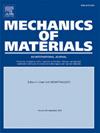The role of crystal orientation in cracking performance of HCP magnesium single crystals
IF 4.1
3区 材料科学
Q2 MATERIALS SCIENCE, MULTIDISCIPLINARY
引用次数: 0
Abstract
This work was committed to conducting atomistic simulations for exploring the crystal orientation dependence of fracture behavior in hexagonal close-packed (HCP) magnesium single crystals. Combined with the traction–separation (T–S) law of the cohesive zone model, microstructure evolutions with various orientations during crack propagation were investigated to probe the anisotropy of crack pattern. We discovered that stress concentrations at the crack tip led to dislocation emission, which was strongly dependent upon the Schmid factor. It was also found that for the (1_210) [10_10] crack orientation, the stress-induced phase transition occurring at the crack tip delayed the crack extension, indicative of the coupling between phase transition and crack propagation. Interestingly, there were several deformation twin types produced at various orientations, which duly affected the crack pattern. Especially for the (0001) [1_210] crack orientation, the formation and growth of {11_21} twins promoted the brittle-to-ductile cracking, which was different from other two orientations. Furthermore, the resultant T–S parameters together with microstructural evolution information revealed the contribution of crystal orientation to intrinsic fracture behavior. This study is expected to offer in-depth insights on the crack-tip behavior induced by crystal orientation, promoting the development of magnesium.

晶体取向对HCP镁单晶开裂性能的影响
本工作致力于通过原子模拟来探索六方密排(HCP)镁单晶断裂行为的晶体取向依赖性。结合黏合带模型的牵引-分离(T-S)规律,研究裂纹扩展过程中不同取向的微观结构演变,探讨裂纹模式的各向异性。我们发现裂纹尖端的应力集中导致位错发射,这与施密德因子密切相关。对于(1_210)[10_10]裂纹取向,裂纹尖端发生的应力诱导相变延迟了裂纹扩展,表明相变与裂纹扩展之间存在耦合关系。有趣的是,在不同的方向上产生了几种变形孪晶,这些变形孪晶相应地影响了裂纹的形态。特别是在(0001)[1_210]裂纹取向中,{11_21}孪晶的形成和扩展促进了脆性到韧性的开裂,这与其他两种取向不同。此外,所得的T-S参数和显微组织演化信息揭示了晶体取向对本征断裂行为的贡献。该研究有望深入了解晶体取向诱导的裂纹尖端行为,促进镁材料的发展。
本文章由计算机程序翻译,如有差异,请以英文原文为准。
求助全文
约1分钟内获得全文
求助全文
来源期刊

Mechanics of Materials
工程技术-材料科学:综合
CiteScore
7.60
自引率
5.10%
发文量
243
审稿时长
46 days
期刊介绍:
Mechanics of Materials is a forum for original scientific research on the flow, fracture, and general constitutive behavior of geophysical, geotechnical and technological materials, with balanced coverage of advanced technological and natural materials, with balanced coverage of theoretical, experimental, and field investigations. Of special concern are macroscopic predictions based on microscopic models, identification of microscopic structures from limited overall macroscopic data, experimental and field results that lead to fundamental understanding of the behavior of materials, and coordinated experimental and analytical investigations that culminate in theories with predictive quality.
 求助内容:
求助内容: 应助结果提醒方式:
应助结果提醒方式:


